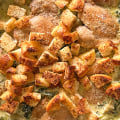Ingredients
- 2 pound beef
- 2 pound pork
- 2 cup dry white wine
- 6 ounce bacon or pancetta
- 1/3 cup garlic cloves
- 2 tablespoon extra-virgin olive oil
- 1/2 teaspoon salt
- 2 teaspoon onions
- 2 teaspoon stalks celery
- 1 teaspoon carrot
- 2 pound beef
- 2 pound pork
- 2 cup dry white wine
- 6 ounce bacon or pancetta
- 1/3 cup garlic cloves
- 2 tablespoon extra-virgin olive oil
- 1/2 teaspoon salt
- 2 teaspoon onions
- 2 teaspoon stalks celery
- 1 teaspoon carrot
- 2 cup dry red wine
- 2 tablespoon tomato paste
- 2 cup tomatoes and juices
- 12 cup hot turkey or vegetable broth
- 12 cup black pepper
- 2 pound beef
- 2 pound pork
- 2 cup dry white wine
- 6 ounce bacon or pancetta
- 1/3 cup garlic cloves
- 2 tablespoon extra-virgin olive oil
- 1/2 teaspoon salt
- 2 teaspoon onions
- 2 teaspoon stalks celery
- 1 teaspoon carrot
- 2 cup dry red wine
- 2 tablespoon tomato paste
- 2 cup tomatoes and juices
- 12 cup hot turkey or vegetable broth
- 12 cup black pepper
- 6 tablespoon tomato paste
- 8 cup milk
- 1/2 cup nutmeg
- 2 cup (or more) hot turkey broth, or hot simple vegetable broth, or plain hot water or a combination of these
- 2 cup black pepper
Preparation
Baking Directions:
Recommended equipmentA 10- to 12-inch diameter heavy bottomed sauce pan or Dutch oven with a 6-quart capacity For both ragú bolognese: preparing the meat and pestata Put all 4 pounds of ground meat in a large mixing bowl.
With your fingers, crumble and loosen it all up; then toss and crumble the beef and pork together.
Pour over the white wine and work all the meat through your fingers again so it's evenly moistened.
To make the pestata, cut the bacon or pancetta slices into 1-inch pieces and put them in the bowl of a food processor with the peeled garlic.
Process them into a fine paste.
For both ragú bolognese: cooking the sauce basePour the olive oil into the heavy saucepan and scrape in all of the pestata.
Set the pan over medium-high heat and break up the pestata, stirring it around the pan bottom to start rendering the fat.
Cook for 3 minutes or more, stirring often, until the bacon and garlic are sizzling and aromatic and there's a good deal of fat in the pan.
Stir the minced onions into the fat and cook for a couple of minutes until sizzling and starting to sweat.
Stir in the celery and carrot and cook the vegetables until wilted and golden, stirring frequently and thoroughly over medium-high heat, about 5 minutes or more.
Turn the heat up a notch, push the vegetables off to the side and plop all the meat into the pan; sprinkle the salt on.
Give the meat on the pan bottom a few moments to brown; then stir, spread, and toss with a sturdy spoon, mixing it in the vegetables, too and making sure every bit of meat browns and begins releasing fat and juices.
Soon the meat liquid will almost cover the meat itself.
Cook at high heat, stirring often, until all that liquid has disappeared, even in the bottom of the pan.
This will take 30 to 45 minutes, depending on the heat and width of the pan.
Stir occasionally, and as the liquid level diminishes, lower the heat too, so the meat doesn't burn.
Heat up slowly the cooking liquids for either the ricetta antica (milk) or the ricetta tradizionale (broth), whichever version you are making.
The procedures for each are different so I am giving them in separate sections.
Long-cooking bolognese tradizionale with wine, tomatoes and brothWhen all the meat liquid has been cooked off, pour in the 2 cups of red wine.
Raise the heat if you've lowered it and stir the meat as the wine comes to a boil.
Cook until the wine has almost completely evaporated, about 5 minutes.
Now drop the 2 tablespoons tomato paste into a clear space on the pan bottom.
Toast it for a minute in the hot spot, then stir to blend it with the meat and let it caramelize for another 2 or 3 minutes.
Pour in the crushed tomatoes and stir; slosh the tomato container out with a cup of hot broth and pour that in too.
Bring the liquid to a boil, stirring the meat, and let the liquid almost boil off, 5 minutes more.
Pour in 2 cups of hot broth, stir well, and add more if needed to cover the meat.
Bring it to an active simmer, cover the pan and adjust the heat to maintain slow steady cooking, with small bubbles perking all over the surface of the sauce.
From this point, the bolognese should cook for 3 hours.
Check the pot every 20 minutes and add hot broth as needed to cover the meat.
The liquid level should be reducing by 1-1/2 to 2 cups between additions: if it's falling much faster and it takes more than 2 cups to cover the meat, lower the heat to slow the evaporation.
If the sauce level drops slowly or not at all, raise the heat and set the cover ajar to speed its concentration.
Stir well at every addition.
Long-cooking bolognese ricetta antica with milkWhen all the meat liquid has been cooked off, drop the 6 tablespoons of tomato paste into a clear space on the pan bottom.
Toast it for a minute in the hot spot, then stir to blend it with the meat and cook for another 2 or 3 minutes.
Pour in 2 cups of the hot milk and stir into the meat; add more milk if needed to bring the level just over the top of the meat.
Grate the nutmeg right above the pan, dropping in at least 1/2 teaspoon, or more if you love it.
Stir it in well; also carefully clear the pan bottom of any caramelized bits, meat or vegetable, as milk will stick in these spots and scorch.
Bring the sauce liquid to an active simmer, cover the pan and adjust the heat to maintain slow steady cooking, with small bubbles perking all over the surface of the sauce.
From this point, the bolognese should cook for 3 hours.
Check the pot every 20 minutes and add hot milk as needed to cover the meat.
The liquid level should be reducing by 1-1/2 to 2 cups between additions, so you'll need to have warm broth or water ready to replenish the sauce after all the milk has been added.
If the sauce level is falling much faster, and it takes more than 2 cups to cover the meat, lower the heat to slow the evaporation.
If the sauce level drops slowly or not at all, raise the heat and set the cover ajar to speed its concentration.
Stir well at every addition (and in between) and make sure nothing's sticking to the bottom.
For the final stage, see finishing the sauce, below.
For both ragú bolognese: finishing the sauce and final steps During the final interval of cooking, you want to reduce the level of the liquid — once milk or broth but now a highly developed sauce.
At the end, the meat should no longer be covered but appear suspended in a thick, flowing medium.
If the meat is still submerged by a lot of liquid, remove the cover completely to cook off moisture quickly.
A few minutes before the end of cooking, taste a bit of meat and sauce and add salt if you want.
Grind 1 teaspoon of black pepper right into the sauce, stir it in and cook about 5 minutes before removing the pan from the heat.
If you'll be using the sauce right away, spoon off the fat from the surface, or stir it in, as is done traditionally.
Otherwise, let the sauce cool, then chill it thoroughly and lift off the solidified fat.
Store the sauce for several days in the refrigerator or freeze it (in measured amounts for different dishes) for use within a few months.




